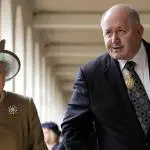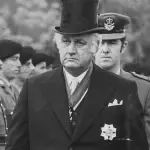
Australia began as a collection of British colonies and we retain strong political connections with Britain. Our political system is a constitutional monarchy. This means that the British monarch is our head of state, however, their powers are constrained or limited by a written constitution. The current queen of Great Britain, Queen Elizabeth II, is our reigning head of state. Since the Queen does not reside in Australia and visits only occasionally, she is represented here by appointed officials. Nationally, the Queen is represented by a governor-general, while in the six States she is represented by six governors. Governors and governors-general are also known as vice-regal officers.
Governor-General: General Sir Peter Cosgrove, AK, MC (pictured above)
Governor of New South Wales: General David Hurley, AC, DSC
Governor of Queensland: Paul de Jersey AC, QC
Governor of South Australia: Hieu Van Le, AO
Governor of Tasmania: Professor Kate Warner, AM
Governor of Victoria: Linda Dessau, AC
Governor of Western Australia: Kim Beazley, AC
The British monarch appoints all vice-regal officers but does not select them personally. Instead, the monarch appoints governors and governors-general on the advice of the government of the day in the relevant jurisdiction. The current Governor-General, Sir Peter Cosgrove, for example, was selected and recommended to the Queen by the Prime Minister, Tony Abbott. There is no constitutional limit on the tenure (term of office) of the Governor-General and State governors, however, the convention is that they serve for five years. They can be removed or replaced by the Queen, on the recommendation of the government, though this has never occurred. Three Governors-General have resigned their commission before their five-year tenure has expired. The last to do so was Doctor Peter Hollingworth, an Anglican archbishop who became Governor-General in 2001. Hollingworth stepped aside in 2003 after claims he had failed to deal appropriately with child sexual abuse in an Anglican school.
A literal reading of the Commonwealth and State constitutions suggest that vice-regal officers are immensely powerful. They are constitutionally empowered to make decisions that could have a significant impact on government and laws, such as refusing assent to bills and dismissing ministers. In practice, however, the Governor-General and State governors play a largely ceremonial role. In almost all cases they simply confirm the decisions of their executive government. Only rarely do governors or governors-general make decisions independently and intervene in government or law-making.

The constitutional powers granted to governors and the Governor-General have become known as the reserve powers, since they exist in reserve and are rarely used. Among the powers of the Governor-General are the authority to order the dissolution of parliament (Section 5) to refuse assent or recommend changes to bills (Section 58) to appoint and dismiss the prime minister and other ministers (Section 64) and the authority to act as commander-in-chief of Australia’s armed forces (Section 68). Examples of governors and Governor-Generals using reserve powers include:
- Governor-General Sir John Kerr’s dismissal of the Whitlam Federal government in November 1975.
- New South Wales governor Sir Phillip Game’s dismissal of the Lang Labor government in 1932.
- Governor-Generals have three times refused prime ministerial requests to dissolve parliament (all between 1904-1909).
In terms of law-making, State governors and the governor-general tend to act as a ‘rubber stamp’, giving assent to whatever bills pass through the parliament. Nevertheless, under the Commonwealth and State constitutions, they retain the power to withhold assent or annul laws. These reserve powers can be used arbitrarily, that is, independently and without restriction. Governors and the governor-general can also defer assent and refer legislation to the monarch for his or her consideration. There have been a few examples of this, usually because the Queen is in Australia at the time and the act is significant. Governor General Sir Ninian Stephen received the Australia Act in December 1985 but decided to defer proclamation of the Act until the Queen’s visit in March 1986, so that she could personally grant assent. Although vice-regal officers are empowered to refuse assent, most constitutional lawyers agree that doing so would place them in an untenable situation and would probably result in their removal or resignation.
© lawgovpol.com 2014. Content on this page may not be republished or distributed without permission. For more information please refer to our Terms of Use.
